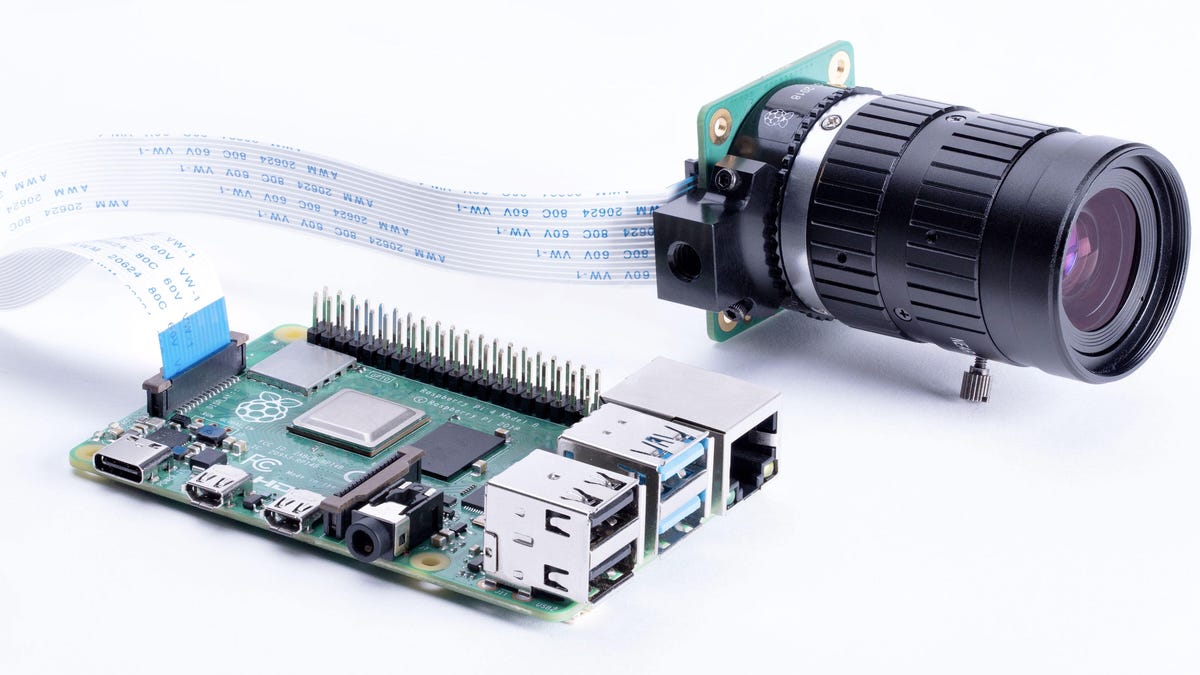Raspberry Pi High Quality Camera opens new doors for DIY projects
You can make your own home security camera or peep on backyard birds.

The Raspberry Pi High Quality Camera is shown here with a separate $50 lens attached and a ribbon cable connection to a Raspberry Pi computer.
Tiny, supercheap Raspberry Pi computers have always been great for do-it-yourself projects, but with the addition of a new high-quality camera this week, they're becoming a better foundation for projects like home security and monitoring backyard wildlife.
The earlier 8-megapixel camera option was nothing special, but the new $50 Raspberry Pi High Quality Camera uses a 12-megapixel Sony IMX477 image sensor with more than twice the light-gathering area for better image quality. You have to buy lenses separately, such as the $25 6mm or $50 16mm models, but it uses standard C- and CS-mount lenses from security cameras for more options.
As with Raspberry Pi itself, there's no shortage of possible projects. They aren't for everybody. But for getting creative, learning how things work and getting some real-world hardware and software engineering skills, Raspberry Pi computers can be great.
Here are some ideas detailed in the accompanying Raspberry Pi Camera Guide, available as a book or a free download:
- A time-lapse camera that takes periodic images that can later be converted into a video so you speed up slow real-world events like flowers blooming or sourdough yeast rising.
- A backyard wildlife camera that uses Google image processing to try to identify what's in a video and that automatically tweets a clip.
- A high-speed camera that shoots video at 120fps and that's triggered when something breaks an infrared beam.
- A stop-motion camera for making step-by-step animations.
- A spy camera activated by an infrared light motion detector.
- An infrared bird-box camera to snoop on avian domestic life.
Some people are already working on projects like making a Raspberry Pi handheld camera, attaching professional SLR camera lenses and streaming backyard bird video to YouTube. Another idea: an automatic dartboard game scorer.
Top-end Raspberry Pi computer costs $55
The current Raspberry Pi 4 models retail for about $35 for a model with 2GB of memory, and $55 for 4GB, though there are other older and cheaper alternatives. They're bare circuit boards, about the size of a credit card, powered by a 1.5GHz quad-core Broadcom BCM2711 processor and accompanied by useful electronics: four USB ports, two mini HDMI ports for connecting displays, an SD card slot for storage, an Ethernet jack, Bluetooth and Wi-Fi. They typically run the Raspbian version of Linux.
The $50 Raspberry Pi High Quality Camera is shown here with a $25 6mm lens.
Cases, power supplies, keyboards, mice and other accessories cost extra. You can also add a variety of HAT devices (short for "hardware attached on top"), like sensors, buttons, LEDs or other gadgets that connect to the Pi's array of input-output pins.
The computers are designed by the Raspberry Pi Foundation, a UK nonprofit that works to bring computing into the lives of students and others who might not be able to afford the latest MacBook. It also encourages people to get out their soldering irons, 3D printers and other hardware for Raspberry Pi-based projects like cat speedometers, hamster feeders and even miniature supercomputing clusters. As of 2019, more than 30 million Raspberry Pi computers have been sold.
You can buy Raspberry Pi computers and accessories at a number of sites, including Adafruit Industries, PiShop, the Pi Hut and Avnet subsidiary Newark Electronics. Some products are out of stock for now.
"We'll have some tens of thousands more coming onto the market in the next couple of weeks," said Raspberry Pi Foundation spokeswoman Liz Upton in an online comment. "We weren't necessarily expecting to sell through on the first day -- these have been popular!"

